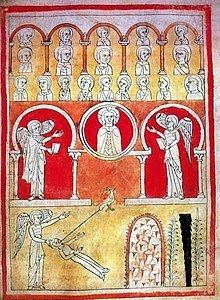Country Portugual Media type laid paper | Publication date 1189 Created 1189 | |
 | ||
Author | ||
The Apocalypse of Lorvão is an illuminated manuscript from Lorvão, Portugal containing the Commentary on the Apocalypse of Beatus of Liébana Monastery, Spain.
Contents
It is currently kept at the Torre do Tombo National Archive in Lisbon.
History
This is a well-dated manuscript and whose origin is identified through its colophon. This indicates that it was completed in 1189 in the scriptorium of the Lorvão monastery in the present municipality of Penacova, near Coimbra. It is signed by the scribe Egeas, which could also be the author of illustrations. It remained preserved in the abbey until the nineteenth century, including when the monastery exchange congregation in 1205 and hosts a Cistercian community.
The historian Alexandre Herculano discovered the manuscript in the library of the monastery in 1853 and transferred it to the national archives of Portugal in Lisbon. It is then intended to be part of the corpus of documents and texts in the history of Portugal (Portugalliae Monumenta Historica). The manuscript is still preserved there.
It is one of 11 manuscripts of Beatus of the Iberian tradition of record of the Memory of the World Register by UNESCO in 2015.
Description
This is the only manuscript of the Beatus Commentary on the Apocalypse of Liébana, also called Beatus, produced in Portugal during the Middle Ages. This is a relatively primitive version of the text, probably copied from the ninth century. It is written in a Carolingian minuscule style that made the transition to the Gothic. His miniatures are at number 70, including 18 full-page, 20 of the half-page and the other smaller and variable dimensions. The manuscript also retains its original binding.
These illustrations were considered archaic for the time, marked by a thick line and colors dominated by orange and yellow. They may have been copied from an older model, perhaps close to the original manuscript of Beatus of Liebana. There are also repeatedly scenes of everyday life, representative of life at the time of Sancho I. Finally, a card or Beatus map belonging to the manuscript is preserved but only in his own half. It was reinstated in the manuscript after being broken up.
